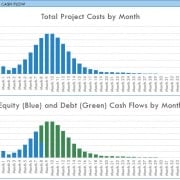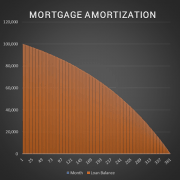Apartment Valuation Tutorial Using the Real Estate Acquisition Model
I promised a how-to video for my real estate apartment acquisition model, and so I thought I’d use an actual property to do so. I grabbed a property from Loopnet that is currently for sale, and dropped the information from the listing into the model. I’m not at all familiar with the property or the sub-market, and thus many of the assumptions are made up. So take the resulting value with a big grain of salt. Nevertheless, the exercise should be more interesting and valuable this way than how I’ve done previous tutorial videos where I’ve simply walked you through the inputs and mechanics of the model.
Download the Excel Model
A few quick notes:
- This multifamily financial model includes 15 tabs, of which three are input tabs, four are output tabs, two are organization tabs, and six are calculation module tabs.
- The model allows for up to 34 unit types.
- The debt module is not overly sophisticated, only allowing for senior debt and not displaying monthly amortization. If you need a more complex debt module, try our advanced real estate amortization table.
If you have any questions, comments, or requests, please don’t hesitate to contact me. I do my best to respond to every inquiry and as promptly as my schedule permits. Happy modeling!
Frequently Asked Questions about the Apartment Valuation Tutorial Using the Real Estate Acquisition Model
What is the purpose of this apartment valuation tutorial?
The tutorial demonstrates how to use the A.CRE Real Estate Acquisition Model to value a multifamily property by inputting real listing data (sourced from LoopNet) into the Excel model. It walks through the valuation process with a real example, making it more practical than generic walkthroughs.
How accurate is the valuation shown in the tutorial?
The valuation is not meant to be precise. The author explicitly states that many assumptions are fabricated, and he is unfamiliar with the property or submarket. The tutorial’s purpose is educational, showing the model’s functionality, not providing an actual valuation.
How many unit types does the model support?
The multifamily acquisition model supports up to 34 unit types, making it suitable for properties with diverse unit mixes.
How many tabs are in the acquisition model, and how are they organized?
There are 15 tabs total in the model:
3 input tabs
4 output tabs
2 organization tabs
6 calculation module tabs
This structure helps users efficiently navigate inputs, outputs, and behind-the-scenes calculations.
Does the model include a detailed debt module?
No. The debt module is not overly sophisticated—it supports only senior debt and does not show monthly amortization. For more complex debt modeling, users are encouraged to try the Advanced Real Estate Amortization Table.
Where can I download the Excel model used in the tutorial?
The Excel model can be downloaded via the link provided in the tutorial. Look for the “Download the Excel Model” section near the top of the post.
Can I use this model for actual deal underwriting?
Yes, but with caution. While the model is functional for first-pass underwriting, the author notes it is not as robust as more advanced models and lacks detailed debt features. For sophisticated analyses, users should consider other tools like the A.CRE All-in-One model.
How can I get help if I have questions about the model?
The author welcomes questions, comments, and requests. Users are encouraged to contact him directly through the information provided in the tutorial. He tries to respond to all inquiries promptly.








